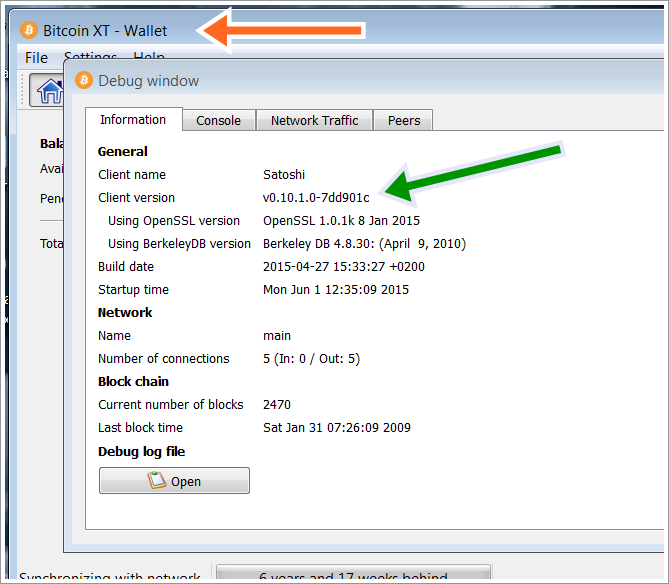Bitcoin XT: Difference between revisions
Clarify |
No edit summary |
||
| Line 3: | Line 3: | ||
|author=[[Gavin Andresen]]<br/>[[Mike Hearn]] | |author=[[Gavin Andresen]]<br/>[[Mike Hearn]] | ||
|website=[https://bitcoinxt.software bitcoinxt.software] | |website=[https://bitcoinxt.software bitcoinxt.software] | ||
}}'''Bitcoin XT''' is a fork of [[Bitcoin Core]] that aims to make transactions reliable, inexpensive, and accessible. It achieved significant | }}'''Bitcoin XT''' is a fork of [[Bitcoin Core]] that aims to make transactions reliable, inexpensive, and accessible. It achieved significant support after prematurely adopting [[BIP 0101|BIP 101]], making it an important proponent of the [[block size limit controversy]].<ref name="ooc">{{cite web|work=[[The Neighbourhood Pool Watch]]|author=[[organofcorti]]|title=BIP101 implementation flaws|date=27 August 2015|accessdate=27 August 2015|url=http://organofcorti.blogspot.com/2015/08/bip101-implementation-flaws.html}}</ref> | ||
After [[Gavin Andresen]]'s resignation from the position of [[Bitcoin Core]] maintainer, he and [[Mike Hearn]] organized{{when}} Bitcoin XT | After [[Gavin Andresen]]'s resignation from the position of [[Bitcoin Core]] maintainer, he and [[Mike Hearn]] organized{{when}} Bitcoin XT.<ref>{{cite web|work=Medium|title=An XT FAQ|author=[[Mike Hearn|Hearn, Mike]]|date=27 August 2015|accessdate=27 August 2015|url=https://medium.com/@octskyward/an-xt-faq-38e78aa32ff0}}</ref> | ||
==Block size hard fork== | ==Block size hard fork== | ||
In 2010, a block size limit was introduced into Bitcoin by [[Satoshi Nakamoto]]. He added it as a safety measure to prevent miners from spamming large blocks and meant for it to be removed once secure lightweight wallets were developed | In 2010, a block size limit was introduced into Bitcoin by [[Satoshi Nakamoto]]. He added it as a safety measure to prevent miners from spamming large blocks and meant for it to be removed once secure lightweight wallets were developed. | ||
There has been much community [[Block size limit controversy|debate]] on this topic. You can read analysis and explanations for why we think raising the block size limit is important here: | There has been much community [[Block size limit controversy|debate]] on this topic. You can read analysis and explanations for why we think raising the block size limit is important here: | ||
| Line 33: | Line 17: | ||
==Miners== | ==Miners== | ||
Miners that side with Bitcoin XT will produce blocks with a new version number.<ref name="avc">{{cite web|title=The Bitcoin XT Fork|work=AVC|author=Wilson, Fred|date=17 August 2015|accessdate=28 August 2015|url=http://avc.com/2015/08/the-bitcoin-xt-fork/}}</ref> This indicates to the rest of the network that they support XT.<ref name="avc"/> When 75% of the last 1000 blocks are new-version blocks, these miners will automatically abandon Bitcoin and begin mining on a new Bitcoin XT blockchain.<ref name="avc"/> This will begin after a waiting period of two weeks in hopes the economy in this time may force anyone who hasn't switched yet to do so.<ref name="avc"/> | Miners that side with Bitcoin XT will produce blocks with a new version number.<ref name="avc">{{cite web|title=The Bitcoin XT Fork|work=AVC|author=Wilson, Fred|date=17 August 2015|accessdate=28 August 2015|url=http://avc.com/2015/08/the-bitcoin-xt-fork/}}</ref> This indicates to the rest of the network that they support XT.<ref name="avc"/> When 75% of the last 1000 blocks are new-version blocks, these miners will automatically abandon Bitcoin and begin mining on a new Bitcoin XT blockchain.<ref name="avc"/> This will begin after a waiting period of two weeks in hopes the economy in this time may force anyone who hasn't switched yet to do so.<ref name="avc"/> | ||
==See Also== | ==See Also== | ||
Revision as of 19:41, 19 October 2015
Bitcoin XT is a fork of Bitcoin Core that aims to make transactions reliable, inexpensive, and accessible. It achieved significant support after prematurely adopting BIP 101, making it an important proponent of the block size limit controversy.[1]
After Gavin Andresen's resignation from the position of Bitcoin Core maintainer, he and Mike Hearn organized[when?] Bitcoin XT.[2]
Block size hard fork
In 2010, a block size limit was introduced into Bitcoin by Satoshi Nakamoto. He added it as a safety measure to prevent miners from spamming large blocks and meant for it to be removed once secure lightweight wallets were developed.
There has been much community debate on this topic. You can read analysis and explanations for why we think raising the block size limit is important here:
- A series of essays by Gavin Andresen
- Why the block size limit must be raised and why the proposed alternative schemes will not work, by Mike Hearn.
Miners
Miners that side with Bitcoin XT will produce blocks with a new version number.[3] This indicates to the rest of the network that they support XT.[3] When 75% of the last 1000 blocks are new-version blocks, these miners will automatically abandon Bitcoin and begin mining on a new Bitcoin XT blockchain.[3] This will begin after a waiting period of two weeks in hopes the economy in this time may force anyone who hasn't switched yet to do so.[3]
See Also
References
- ↑ organofcorti (27 August 2015). "BIP101 implementation flaws". The Neighbourhood Pool Watch. http://organofcorti.blogspot.com/2015/08/bip101-implementation-flaws.html. Retrieved 27 August 2015.
- ↑ Hearn, Mike (27 August 2015). "An XT FAQ". Medium. https://medium.com/@octskyward/an-xt-faq-38e78aa32ff0. Retrieved 27 August 2015.
- ↑ 3.0 3.1 3.2 3.3 Wilson, Fred (17 August 2015). "The Bitcoin XT Fork". AVC. http://avc.com/2015/08/the-bitcoin-xt-fork/. Retrieved 28 August 2015.

